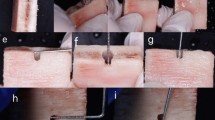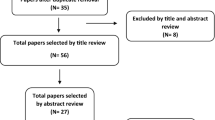Abstract
Objectives
This study aims to study the accuracy of cone beam computed tomography (CBCT) for measuring peri-implant bone thickness in living patients via a novel visualization method (NVM).
Material and methods
The validity of the NVM was verified ex vivo by measuring the same peri-implant bone thicknesses in bovine ribs by using raw postoperative CBCT (clinical measurement, CM), the visualized fused images obtained using the NVM (visualized fused measurement, VF), and hard tissue sections (gold standard measurement, GS). The NVM was applied by deconstructing the postoperative CBCT model into the Modelpost-bone and Modelimplant and replacing it with bone from preoperative CBCT and standard implant models, respectively. In vivo, 52 implants were included, and the VF of each implant was obtained using data processing methods similar to those used ex vivo. Then, we compared the results of CM and VF.
Results
Ex vivo, the VF was similar to GS, while CM usually underestimated the peri-implant bone thickness, especially at the implant shoulder (P < 0.01). In vivo, on CBCT, areas with a peri-implant bone thickness of 0–0.50 mm were not visible, while those with a thickness of 0.50–1.00 mm were occasionally visible. There was less underestimation of bone along the implant long axis.
Conclusions
Thin peri-implant bones could be completely underestimated on CBCT. CBCT scans alone are insufficient to warrant surgical intervention. Our NVM facilitates the accurate visual assessment of implant dimensions.
Clinical Relevance
The thickness of peri-implant bone could be completely underestimated when thinner than 1.0 mm in living patients. Familiarity with these confusing CBCT results may help clinicians and patients avoid further unnecessary evaluation, misdiagnosis, and invasive treatment.






Similar content being viewed by others
Abbreviations
- CBCT:
-
Cone beam computed tomography
- NVM:
-
Novel visualization method
- VF:
-
Visualized fused measurement
- GS:
-
Gold standard
- CM:
-
Clinical measurement
- BT:
-
Bone thickness
- IB:
-
Implant blooming
- CI:
-
Confidence interval
- ICC:
-
Intraclass correlation coefficient
References
Albrektsson T, Dahl E, Enbom L, Engevall S, Engquist B, Eriksson AR et al (1988) Osseointegrated oral implants A Swedish multicenter study of 8139 consecutively inserted Nobelpharma implants. J Periodontol 59(5):287–296. https://doi.org/10.1902/jop.1988.59.5.287
Jemt T, Johansson J (2006) Implant treatment in the edentulous maxillae: a 15-year follow-up study on 76 consecutive patients provided with fixed prostheses. Clin Implant Dent Relat Res 8(2):61–69. https://doi.org/10.1111/j.1708-8208.2006.00003.x
Merli M, Merli M, Mariotti G, Pagliaro U, Moscatelli M, Nieri M (2020) Immediate versus early non-occlusal loading of dental implants placed flapless in partially edentulous patients: a 10-year randomized clinical trial. J Clin Periodontol 47(5):621–629. https://doi.org/10.1111/jcpe.13279
Buser D, Janner SF, Wittneben JG, Brägger U, Ramseier CA, Salvi GE (2012) 10-year survival and success rates of 511 titanium implants with a sandblasted and acid-etched surface: a retrospective study in 303 partially edentulous patients. Clin Implant Dent Relat Res 14(6):839–851. https://doi.org/10.1111/j.1708-8208.2012.00456.x
French D, Ofec R, Levin L (2021) Long term clinical performance of 10 871 dental implants with up to 22 years of follow-up: a cohort study in 4247 patients. Clin Implant Dent Relat Res 23(3):289–297. https://doi.org/10.1111/cid.12994
Karoussis IK, Salvi GE, Heitz-Mayfield LJA, Bragger U, Hammerle CHF, Lang NP (2003) Long-term implant prognosis in patients with and without a history of chronic periodontitis: a 10-year prospective cohort study of the ITI (R) dental implant system. Clin Oral Implants Res 14(3):329–339. https://doi.org/10.1034/j.1600-0501.000.00934.x
Buser D, Martin W, Belser UC (2004) Optimizing esthetics for implant restorations in the anterior maxilla: anatomic and surgical considerations. Int J Oral Maxillofac Implants 19(Suppl):43–61
Spray JR, Black CG, Morris HF, Ochi S (2000) The influence of bone thickness on facial marginal bone response: stage 1 placement through stage 2 uncovering. Ann Periodontol 5(1):119–128. https://doi.org/10.1902/annals.2000.5.1.119
Quirynen M, van Steenberghe D, Jacobs R, Schotte A, Darius P (1991) The reliability of pocket probing around screw-type implants. Clin Oral Implants Res 2(4):186–192. https://doi.org/10.1034/j.1600-0501.1991.020405.x
Schou S, Holmstrup P, Stoltze K, Hjorting-Hansen E, Fiehn NE, Skovgaard LT (2002) Probing around implants and teeth with healthy or inflamed peri-implant mucosa/gingiva - a histologic comparison in cynomolgus monkeys (Macaca fascicularis). Clin Oral Implants Res 13(2):113–126. https://doi.org/10.1034/j.1600-0501.2002.130201.x
Serino G, Turri A, Lang NP (2013) Probing at implants with peri-implantitis and its relation to clinical peri-implant bone loss. Clin Oral Implants Res 24(1):91–95. https://doi.org/10.1111/j.1600-0501.2012.02470.x
Aizcorbe-Vicente J, Peñarrocha-Oltra D, Canullo L, Soto-Peñaloza D, Peñarrocha-Diago M (2020) Influence of facial bone thickness after implant placement into the healed ridges on the remodeled facial bone and considering soft tissue recession: a systematic review. Int J Oral Maxillofac Implants 35(1):107–119. https://doi.org/10.11607/jomi.7259
Merheb J, Vercruyssen M, Coucke W, Beckers L, Teughels W, Quirynen M (2017) The fate of buccal bone around dental implants. A 12-month postloading follow-up study. Clin Oral Implants Res 28(1):103–108. https://doi.org/10.1111/clr.12767
Bertram S, Emshoff R (2008) Sonography of periimplant buccal bone defects in periodontitis patients: a pilot study. Oral Surg Oral Med Oral Pathol Oral Radiol Endod 105(1):99–103. https://doi.org/10.1016/j.tripleo.2007.01.014
Choi M, Culjat MO, Singh RS, White SN (2012) Ultrasound imagery for dental implant diagnosis and treatment planning in a porcine model. J Prosthet Dent 108(6):344–353. https://doi.org/10.1016/S0022-3913(12)60190-5
Fourmousis I, Brägger U, Bürgin W, Tonetti M, Lang NP (1994) Digital image processing. II. In vitro quantitative evaluation of soft and hard peri-implant tissue changes. Clin Oral Implants Res 5(2):105–114. https://doi.org/10.1034/j.1600-0501.1994.050207.x
Marconcini S, Giammarinaro E, Toti P, Alfonsi F, Covani U, Barone A (2018) Longitudinal analysis on the effect of insertion torque on delayed single implants: a 3-year randomized clinical study. Clin Implant Dent Relat Res 20(3):322–332. https://doi.org/10.1111/cid.12586
Jacobs R, Vranckx M, Vanderstuyft T, Quirynen M, Salmon B (2018) CBCT vs other imaging modalities to assess peri-implant bone and diagnose complications: a systematic review. Eur J Oral Implantol 11(Suppl 1):77–92
Schulze RK, Berndt D, d’Hoedt B (2010) On cone-beam computed tomography artifacts induced by titanium implants. Clin Oral Implants Res 21(1):100–117. https://doi.org/10.1111/j.1600-0501.2009.01817.x
Razavi T, Palmer RM, Davies J, Wilson R, Palmer PJ (2010) Accuracy of measuring the cortical bone thickness adjacent to dental implants using cone beam computed tomography. Clin Oral Implants Res 21(7):718–725. https://doi.org/10.1111/j.1600-0501.2009.01905.x
Scarfe WC, Farman AG (2008) What is cone-beam CT and how does it work?, Dent Clin North Am 52(4) 707–30, v. https://doi.org/10.1016/j.cden.2008.05.005
Vanderstuyft T, Tarce M, Sanaan B, Jacobs R, de FariaVasconcelos KD, Quirynen M (2019) Inaccuracy of buccal bone thickness estimation on cone-beam CT due to implant blooming: an ex-vivo study. J Clin Periodontol 46(11):1134–1143. https://doi.org/10.1111/jcpe.13183
Bryant JA, Drage NA, Richmond S (2008) Study of the scan uniformity from an i-CAT cone beam computed tomography dental imaging system. Dentomaxillofac Rad 37(7):365–374. https://doi.org/10.1259/dmfr/13227258
Benic GI, Sancho-Puchades M, Jung RE, Deyhle H, Hämmerle CHF (2013) In vitro assessment of artifacts induced by titanium dental implants in cone beam computed tomography. Clin Oral Implants Res 24(4):378–383. https://doi.org/10.1111/clr.12048
Li JY, Pow EHN, Zheng LW, Ma L, Kwong DLW, Cheung LK (2014) Quantitative analysis of titanium-induced artifacts and correlated factors during micro-CT scanning. Clin Oral Implants Res 25(4):506–510. https://doi.org/10.1111/clr.12200
Bartnikowski M, Vaquette C, Ivanovski S (2020) Workflow for highly porous resorbable custom 3D printed scaffolds using medical grade polymer for large volume alveolar bone regeneration. Clin Oral Implants Res 31(5):431–441. https://doi.org/10.1111/clr.13579
Maes F, Collignon A, Vandermeulen D, Marchal G, Suetens P (1997) Multimodality image registration by maximization of mutual information. IEEE Trans Med Imaging 16(2):187–198. https://doi.org/10.1109/42.563664
Huang J, Hu J, Luo R, Xie S, Wang Z, Ye Y (2019) Linear measurements of sinus floor elevation based on voxel-based superimposition of cone beam computed tomography images. Clin Implant Dent Relat Res 21(5):1048–1053. https://doi.org/10.1111/cid.12830
Zhou Y, Si M, Liu Y, Wu M (2019) Likelihood of needing facial bone augmentation in the anterior maxilla of Chinese Asians: a cone beam computed tomography virtual implant study. Clin Implant Dent Relat Res 21(3):503–509. https://doi.org/10.1111/cid.12787
Bland JM, Altman DG (1986) Statistical methods for assessing agreement between two methods of clinical measurement. Lancet 1(8476):307–310. https://doi.org/10.5271/sjweh.3960
Flanagan D (2003) Important arterial supply of the mandible, control of an arterial hemorrhage, and report of a hemorrhagic incident. J Oral Implantol 29(4):165–173. https://doi.org/10.1563/1548-1336(2003)029%3c0165:IASOTM%3e2.3.CO;2
Tomljenovic B, Herrmann S, Filippi A, Kühl S (2016) Life-threatening hemorrhage associated with dental implant surgery: a review of the literature. Clin Oral Implants Res 27(9):1079–1084. https://doi.org/10.1111/clr.12685
Monnin P, Sfameni N, Gianoli A, Ding S (2018) Optimal slice thickness for object detection with longitudinal partial volume effects in computed tomography [published correction appears in J Appl Clin Med Phys 19(3):408. J Appl Clin Med Phys. 2017;18(1):251-259. https://doi.org/10.1002/acm2.12005
de-Azevedo-Vaz SL, Peyneau PD, Ramirez-Sotelo LR, Vasconcelos Kde F, Campos PS, Haiter-Neto F (2016) Efficacy of a cone beam computed tomography metal artifact reduction algorithm for the detection of peri-implant fenestrations and dehiscences. Oral Surg Oral Med Oral Pathol Oral Radiol 121(5):550–556. https://doi.org/10.1016/j.oooo.2016.01.013
Codari M, de FariaVasconcelos K, FerreiraPinheiroNicolielo L, HaiterNeto F, Jacobs R (2017) Quantitative evaluation of metal artifacts using different CBCT devices, high-density materials and field of views. Clin Oral Implants Res 28(12):1509–1514. https://doi.org/10.1111/clr.13019
Spin-Neto R, Gotfredsen E, Wenzel A (2013) Impact of voxel size variation on CBCT-based diagnostic outcome in dentistry: a systematic review. J Digit Imaging 26(4):813–820. https://doi.org/10.1007/s10278-012-9562-7
Farman AG, Farman TT (2005) A comparison of 18 different x-ray detectors currently used in dentistry. Oral Surg Oral Med Oral Pathol Oral Radiol Endod 99(4):485–489. https://doi.org/10.1016/j.tripleo.2004.04.002
Abella F, Mercadé M, Duran-Sindreu F, Roig M (2011) Managing severe curvature of radix entomolaris: three-dimensional analysis with cone beam computed tomography. Int Endod J 44(9):876–885. https://doi.org/10.1111/j.1365-2591.2011.01898.x
Spin-Neto R, Costa C, Salgado DM, Zambrana NR, Gotfredsen E, Wenzel A (2018) Patient movement characteristics and the impact on CBCT image quality and interpretability. Dentomaxillofac Radiol 47(1):20170216. https://doi.org/10.1259/dmfr.20170216
Araki K, Okano T (2013) The effect of surrounding conditions on pixel value of cone beam computed tomography. Clin Oral Implants Res 24(8):862–865. https://doi.org/10.1111/j.1600-0501.2011.02373.x
Parsa A, Ibrahim N, Hassan B, Motroni A, van der Stelt P, Wismeijer D (2013) Influence of cone beam CT scanning parameters on grey value measurements at an implant site. Dento Maxillo Fac Radiol 42(3):79884780. https://doi.org/10.1259/dmfr/79884780
Schriber M, Yeung AWK, Suter VGA, Buser D, Leung YY, Bornstein MM (2020) Cone beam computed tomography artifacts around dental implants with different materials influencing the detection of peri-implant bone defects. Clin Oral Implants Res 31(7):595–606. https://doi.org/10.1111/clr.13596
Acknowledgements
The authors thank Yuzhu Jia (radiologist at Tongde Hospital of Zhejiang province) and Dr. Bin Feng (radiologist of Stomatology Hospital, Zhejiang University School of Medicine) for their support during the revision of the manuscript.
Funding
This work was supported by the Zhejiang province Health Science Major Project (WKJ-ZJ-2034) and the National Natural Science Foundation of China (81771118).
Author information
Authors and Affiliations
Contributions
Yanhua Lan, conceptualization, data curation, formal analysis, methodology, and writing—original draft preparation. Xiaoyuan Huang, data curation, formal analysis, methodology, and writing—original draft preparation. Mingxing Fan, data curation, formal analysis, and methodology. Huazhen Yu, statistical analysis and validation. Zhijian Xie, supervision and writing—review and editing. Yiqun Zhou, conceptualization, methodology, and writing—review and editing.
Corresponding authors
Ethics declarations
Ethics approval
Approval was provided by the Ethics Review Board of the Affiliated Stomatology Hospital of Zhejiang University (number: ZHUSSIRB-201508).
Consent to participate
All patients signed an ethical board-approved written informed consent form.
Conflict of interest
The authors declare no competing interests.
Additional information
Publisher's note
Springer Nature remains neutral with regard to jurisdictional claims in published maps and institutional affiliations.
Supplementary Information
Below is the link to the electronic supplementary material.
Rights and permissions
About this article
Cite this article
Lan, Y., Huang, X., Fan, M. et al. Accuracy evaluation of cone beam computed tomography applied to measure peri-implant bone thickness in living patients: an ex vivo and in vivo experiment. Clin Oral Invest 26, 6347–6359 (2022). https://doi.org/10.1007/s00784-022-04590-y
Received:
Accepted:
Published:
Issue Date:
DOI: https://doi.org/10.1007/s00784-022-04590-y




